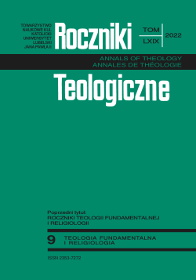Pełnia życia w tradycyjnej religii Mae Enga i Chrystus-Życie
Abstrakt
Niniejsza prezentacja jest próbą stworzenia przestrzeni dialogu pomiędzy chrześcijaństwem a kulturą. Jezus Chrystus wkracza w dzisiejszą rzeczywistość społeczno-kulturową ludzi Mae Enga, aby ją przemienić, a także zaoferować nową tożsamość i nowy wymiar w ich poszukiwaniach pełni życia. Z kolei Mae Enga oferuje światu „Oblicze Chrystusa” z rysami i wartościami własnej kultury, kultu i pojednania.
Artykuł bazuje na badaniach antropologów, jak również na wywiadach z 80 osobami: 60 osób wzięło udział w wywiadach osobistych, a 20 uczestniczyło w dyskusjach prowadzonych w grupach. Rezultaty badań pokazują, że tradycyjne życie ludzi Mae Enga ukierunkowane jest na życiodajne relacje z całym wszechświatem, które warunkują doświadczenie upragnionej “pełni życia” tu na ziemi, w kręgu członków własnego klanu. Pomimo nieuchronnych zmian społeczno-kulturowych, które wpływają na ich wartości, wierzenia i postawy, życie jest wciąż najwyższą wartością, ale dzisiejsza młodzież wybiera współczesne sposoby, by je osiągnąć. Religia tradycyjna ustępuje miejsca Chrystusowi, Panu Życia, który obala bariery pojedynczych klanów i daje im nową tożsamość naśladowców Chrystusa; Ktaisanya Tata (Tribe of Jesus Christ).
Bibliografia
Brennan, Paul. Let Sleeping Snakes Lie. Special Studies in Religion. Adelaide: Australian Association for the Study of Religions, 1977.
Dlugosz, Miriam. Mae Enga Myths and Christ’s Message. Fullness of Life in Mae Enga Mythology and Christ the Life (Jn 10:10). Nettetal: Steyler Verlag, 1998.
Dlugosz, Miriam. “Ministering in Oral Cultures Today.” Australian Association for Mission Studies 14, no. 2 (2020): 48–52.
Dlugosz, Miriam. “Changing Perception on the Role of Enga Woman in the Society Today in Kompiam-Ambum District, Enga.” Catalyst 50, no. 1 (2020): 39–63.
Dlugosz, Miriam. “Christ as Kamongo Saka Katao Katenge—The Lord of Life, in the Context of Enga Culture.” In Becoming Intercultural. Perspectives on Mission, edited by Stanislaus T. Lazarus and Christian Tauchner, 327–46. Delhi: ISPCK/Steyler Missionswissenschaftliches Institut, 2021.
Gesch, Patrick. Initiative and Initiation. A Cargo Cult-Type Movement in the Sepik against its Background in Traditional Village Religion. Studia Instituti Anthropos 33. St. Augustin: Anthropos Institut, 1985.
Gibbs, Phil. “The Gospel of Christ in Enga.” In Gospel transformations. SVD’s Reflect on Gospel Preaching in Papua New Guinea, edited by Patrick Gesch, 33–41. Madang: Divine Word Institute, 1994.
Gibbs, Phil. “Titi Pingi, Theology of an Enga Praise Poem.” Catalyst 20/2 (1990): 117–136.
Gibbs, Phil. “Beyond the Fence: Confronting Witchcraft Accusations in the Papua New Guinea Highlands”. International Bulletin of Missionary Research 39/1 (2015): 8–11.
Gibbs, Phil. “I could be the last man: Changing masculinities in Enga society”. The Asia Pacific Journal of Anthropology 17, nos. 3–4 (2016): 324–41. https://doi.org/ 10.1080/14442213. 2016.1179783.
Jentsch, Thunar, and Rainer Doetsch. Keman eine Siedlung im Hochland von Papua Neuguinea. Berlin: Dietrich Reimer, 1986.
Kambao, Lawrence. “The discovery of Weapo Yahweh in Enga Laiapu”. Catalyst 19, no. 4 (1998): 385–98.
Krol, Anthony. Pumakos Parish till 1982. Alexishafen: Stella Press, 1991.
Kyakas, Alome, and Polly Wiessner. From Inside the Women’s House. Enga Women’s Lives and Traditions. Buranda, Qld: Robert Brown and Associates, 1991.
Lacey, Rodrick. “The Introduction of Cash Cropping to the Western Highlands: Some Evidence from Enga.” In Melanesia beyond Diversity, edited by R. J. May and Hank Nelson, 351–71. Canberra: Research School of Pacific Studies, Australian National University, 1982.
Lacey, Rodrick. “The Enga Worldview”. Catalyst 3 (1973): 37–47.
Lacey, Rodrick. “Heroes, 3: Themes in Precolonial Religious Life in Papua New Guinea”. In Powers, Plumes and Piglets: Phenomena of Melanesian Religion, 194–209. Australian Association for the Study of Religions, 1979.
Mantovani, Ennio. Traditional and Present Day Melanesian Values and Ethics. Occasional Papers of the Melanesian Institute 7. Goroka: Melanesian Institute for Pastoral and Socio-Economic Service, 1993.
Narokobi, Bernard. “What is Religious Experience for a Melanesian?” in Christ in Melanesia: Exploring Theological Issues, ed. James Knight, 7–12. Goroka: Melanesian Institute foe Pastoral and Socio-Economic Service, 1977.
Otto, Rudolf. The Idea of the Holy. Translated by J. Harvey. London: Oxford University Press, 1958.
Pernia, Anthony. “The theological significance of multiculturality.” Missio Ad Gentes 2, no. 2. (2016): 2–18.
Pokawin, Stephen. “Cargo cults and development,” Point 1 (1979): 83–95.
Rusoto, Moses R. “Traditional, Western Mae Enga Religion.” Oral History 8, no. 7 (1980): 1–45.
Schroeder, Roger. Initiation and Religion. A Case Study from the Wosera of Papua New Guinea. Fribourg: University Press, 1992.
Wagner, Herdwig, and Herman Reiner, eds. The Lutheran Church in Papua New Guinea. The First Hundred Years (1886–1986). Adelaide: Lutheran Publishing House, 1987.
Wagner, Herdwig. “The Enga Concept of Fear”. In Studies in Missionary Anthropology, edited by Paul Brennan, 245–318. Wapenamanda, 1970.
Copyright (c) 2022 Roczniki Teologiczne

Utwór dostępny jest na licencji Creative Commons Uznanie autorstwa – Użycie niekomercyjne – Bez utworów zależnych 4.0 Międzynarodowe.





